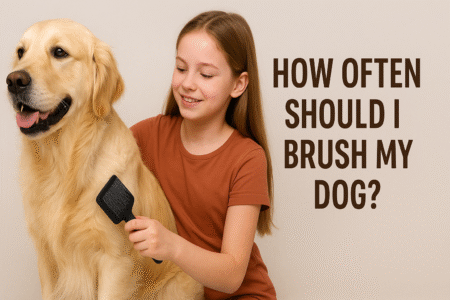Flea infestations affect over 6 million dogs in the United States each year. They cause discomfort, allergic reactions, and even diseases. If your dog is infested with fleas, using flea shampoo can help manage the problem.
Flea shampoo is made to kill fleas and other parasites on your dog’s coat. But, it’s important to find the right time to bathe your dog. Bathing too much can cause skin irritation and dryness.
Knowing how to manage flea infestations and using the right flea shampoo is key. It helps keep your dog comfortable and healthy.
Understanding Flea Infestations in Dogs
Fleas can cause more than just itching in dogs; they can lead to serious health issues if not addressed. Flea infestations are a widespread problem that can affect dogs of all ages and breeds. Understanding the signs and risks associated with flea infestations is key for dog owners to provide the best care for their pets.
Common Signs Your Dog Has Fleas
Identifying a flea infestation early is key to preventing more severe problems. Common signs include excessive scratching, restlessness, and skin irritation. You might also notice tiny, dark specks on your dog’s coat, which are flea droppings. In severe cases, dogs may develop flea allergy dermatitis, a condition that causes intense itching and skin lesions.
| Signs | Description |
| Excessive Scratching | Dogs scratch more than usual due to flea bites. |
| Skin Irritation | Flea bites cause redness and irritation on the skin. |
| Flea Droppings | Tiny, dark specks on the dog’s coat, often mistaken for dirt. |
Health Risks Associated with Flea Infestations
Flea infestations are not just a nuisance; they can lead to significant health risks. Fleas can transmit tapeworms and other diseases to dogs. In addition, flea bites can cause allergic reactions, leading to discomfort and skin problems. In severe cases, flea infestations can result in anemia, which is dangerous, mainly in puppies or dogs with pre-existing health conditions.
The Purpose of Flea Shampoo for Dogs
Flea shampoos are key in fighting flea infestations. They kill fleas and other parasites on dogs, giving them relief from itching. Using flea shampoo is a big part of keeping dogs flea-free.
How Flea Shampoos Work
Flea shampoos have special ingredients that target fleas at different life stages. These ingredients, like permethrin or pyrethrin, disrupt the flea’s nervous system, killing them. Knowing how these ingredients work helps pick the best flea shampoo for your dog.
Active Ingredients and Their Mechanisms
The success of a flea shampoo depends on its active ingredients. For example, permethrin paralyzes and kills fleas. Pyrethrin, from chrysanthemum flowers, also kills insects. Knowing what’s in your shampoo helps choose the right one for your dog.
Different Types of Flea Treatments
Flea shampoos are just one way to fight fleas. Other options include topical treatments, oral medications, and environmental treatments. Topical treatments are applied to the dog’s skin and last for weeks. Oral medications kill fleas from the inside out.
Comparing Shampoos to Other Treatment Options
Choosing a flea treatment depends on what works best for your dog. Flea shampoos offer quick relief and can be used with other treatments. But, they need to be used often. Topical and oral treatments last longer but might not act as fast as shampoos. Mixing different treatments is usually the best way to keep fleas away.
When to Use Flea Shampoo on Your Dog
Knowing when to use flea shampoo on your dog is key for controlling fleas. Flea shampoo can help manage flea problems, but it works best if used correctly.
Choosing to use flea shampoo depends on your dog’s needs. It’s useful for both treating active infestations and preventing future ones. The timing of when you use it can greatly affect its success.
Active Infestations vs. Preventative Use
If your dog has fleas, flea shampoo can offer quick relief. It kills fleas and helps soothe your dog’s skin. For preventing fleas, using flea shampoo regularly, mainly during flea season, is a good idea.
- For dogs with fleas, bathe them with flea shampoo as needed, following the product’s guidelines.
- For preventing fleas, add flea shampoo to your dog’s regular baths during flea season.
Seasonal Considerations for Flea Treatment
Fleas are more active in warmer months. In places with mild winters, fleas can be a problem all year.
To keep fleas away, follow these seasonal tips:
- Be extra careful during peak flea seasons (summer and early fall).
- Change your flea control plan based on local flea activity.
- Keep up a regular preventative routine to stop infestations.
By understanding flea patterns and adjusting your control methods, you can keep your dog safe from fleas.
Factors to Consider When Choosing a Flea Shampoo
Choosing the right flea shampoo for your dog is key for effective flea control. There are many options, so it’s important to think about a few things. This ensures you pick the best product for your dog’s needs.
Natural vs. Chemical Formulations
Flea shampoos are either natural or chemical-based. Natural shampoos use things like essential oils and plants. They are often gentler on your dog’s skin. On the other hand, chemical-based shampoos have ingredients like pyrethroids. They might work better but could also cause skin irritation.

Dog-Specific Considerations
When picking a flea shampoo, think about your dog’s unique needs. Things like age, size, breed, and coat type matter a lot. They can affect how well a shampoo works for your dog.
Age and Size Factors
Puppies and older dogs need gentle shampoos to avoid skin problems. Also, the size of your dog will affect how much shampoo you need. Make sure the product has instructions based on your dog’s weight.
Breed and Coat Type Considerations
Some breeds have special coat types that might get irritated easily. Dogs with sensitive skin or long hair might need special shampoos. These shampoos are made to help with these specific needs.
Reading Labels and Understanding Ingredients
To pick the best flea shampoo, read the label carefully. Know what’s in it, how much, and how to use it. This helps you make a good choice and use it right. It’s also important to know how often to bathe your dog with flea shampoo to keep fleas away without over-bathing.
How Often to Bathe Your Dog with Flea Shampoo
Bathing your dog with flea shampoo is key to fighting fleas. But how often should you do it? It depends on the flea problem’s severity and your dog’s needs.
Recommended Frequency for Active Infestations
When fleas are active, bathe your dog with flea shampoo once a week. This helps cut down the flea numbers and makes your dog more comfortable. Consistency is key to get rid of fleas, targeting both adults and eggs.
Maintenance Bathing Schedule
After controlling the flea problem, switch to a maintenance schedule. Most dogs need flea shampoo baths every 4-6 weeks to keep fleas away. But, this can change based on your dog’s flea exposure and sensitivity.
Adjusting Frequency Based on Your Dog’s Needs
Watch how your dog reacts to flea shampoo and adjust bath times as needed. Your dog’s age, health, and lifestyle play a big role in how often they should be bathed.
Signs You’re Bathing Too Frequently
- Dry, irritated skin
- Increased shedding
- Redness or inflammation
If you see these signs, it might be time to reduce bath frequency or use a milder flea shampoo.
Signs You Need to Increase Bathing Frequency
- Persistent flea infestation
- Visible fleas or flea dirt
- Continued discomfort or itching
If your dog keeps showing flea signs, even with regular baths, you might need to increase bath frequency or try other flea control methods.
Proper Application Techniques for Maximum Effectiveness
Getting flea shampoo right is key to fighting off fleas. To make sure your flea shampoo works best, follow some important steps.
Pre-Bath Preparation
Before you start, brush your dog’s coat to get rid of tangles. This makes the shampoo spread evenly. Make sure the bathing area is well-ventilated and quiet.
Step-by-Step Application Method
To apply flea shampoo right:
- Wet your dog’s coat with lukewarm water.
- Put the shampoo on, starting at the head and going down to the tail. Be careful around the eyes, ears, and nose.
- Massage the shampoo into the coat, making sure it gets to the skin.
- Rinse well with lukewarm water.
Contact Time Requirements
The time the shampoo stays on is key. Keep it on for 5 to 10 minutes before rinsing.
Why Timing Matters
The time lets the shampoo kill fleas and their eggs. Rinsing too early can make it less effective. Always follow the product’s instructions for the best results.
| Application Step | Action | Importance |
| Pre-Bath Preparation | Brush coat, prepare bathing area | Ensures even distribution, reduces distractions |
| Application | Wet coat, apply shampoo, massage, rinse | Ensures shampoo reaches skin, effective flea killing |
| Contact Time | Leave shampoo on for recommended time | Allows active ingredients to work effectively |
Determining the Right Amount of Flea Shampoo to Use
To use the right amount of flea shampoo, follow the guidelines based on your dog’s weight. Too little might not treat the fleas well. Too much can harm your dog.
Dosage Guidelines Based on Dog Size
The right flea shampoo dose depends on your dog’s weight. Always check the product label for exact instructions. Here are some general guidelines:
- Small dogs (under 10 lbs): 1/4 of the recommended dose
- Medium dogs (10-20 lbs): 1/2 of the recommended dose
- Large dogs (20-40 lbs): 3/4 of the recommended dose
- Extra-large dogs (over 40 lbs): Full recommended dose
Signs of Using Too Much or Too Little
It’s important to watch how your dog reacts to the flea shampoo. Too much can irritate the skin. Too little might not get rid of the fleas.
Skin Reactions to Watch For
Look out for skin reactions like redness, itching, or rashes. If you see these signs, rinse your dog well and talk to your vet.
Safety Precautions When Using Flea Shampoo
Using flea shampoo safely is important to avoid harm to dogs and their owners. It’s key to know the risks and how to avoid them.

Protecting Yourself During Application
Wear gloves to protect your skin when applying flea shampoo. Choose old clothes that can be washed right away. Make sure the area is well-ventilated to avoid breathing in the shampoo’s fumes.
Preventing Accidental Ingestion or Eye Contact
Keep flea shampoo away from children and pets to avoid accidents. Be careful not to get it in your dog’s eyes, ears, or mouth. If it happens, rinse the area well with water. If needed, get vet advice.
Monitoring for Adverse Reactions
Watch your dog closely after using flea shampoo for any bad reactions. Look for skin issues, too much scratching, or feeling tired. If you see anything odd, talk to your vet.
When to Seek Veterinary Help
If your dog has serious reactions like trouble breathing, a fast heartbeat, or seizures, get vet help fast. Also, if the flea problem doesn’t get better or gets worse, ask your vet for more advice.
Complementary Flea Control Methods
Beyond using flea shampoo, there are other ways to control fleas on your dog and at home. A complete plan is needed to fight flea infestations well.
Environmental Treatment
It’s important to treat your environment to control fleas. This means washing your dog’s bedding, vacuuming carpets, and using flea sprays or foggers. Cleaning areas where your dog hangs out can really cut down flea numbers.
Oral and Topical Preventatives
Using flea shampoo is just the start. Oral or topical preventatives offer ongoing protection. These products are given monthly and keep fleas away. Talk to your vet to find the best one for your dog.
Creating a Complete Flea Control Plan
A good flea control plan uses many strategies. This includes bathing with flea shampoo, treating your environment, and using preventatives. A multi-faceted approach helps manage fleas on your dog and at home. Keep an eye on it and make changes as needed for lasting results.
Special Considerations for Sensitive Dogs
If your dog is sensitive, bathing them with flea shampoo needs extra care. Sensitive dogs can have bad reactions to some ingredients. It’s important to pick a flea shampoo that meets their needs.

Guidelines for Puppies and Senior Dogs
Puppies and senior dogs need special care when using flea shampoo. Puppies should wait until they are at least 12 weeks old. Before using flea treatments on senior dogs, talk to your vet. They might have health issues.
Adapting Treatment for Dogs with Skin Conditions
Dogs with skin problems, like allergies or dermatitis, need special flea treatments. Choose a shampoo that is gentle and hypoallergenic. This helps avoid irritation. Always check with your vet for the best treatment.
Alternative Options for Flea-Sensitive Dogs
For dogs that can’t handle flea shampoos, there are other ways to control fleas. Options include oral preventatives, topical treatments, and environmental treatments. Your vet can help find the best one for your dog.
By thinking about your dog’s sensitivity and adjusting your approach, you can keep fleas away. This way, you also keep your dog comfortable and healthy.
Conclusion
Bathing your dog with flea shampoo is key to fighting fleas. Knowing how often to do it is important. This depends on how bad the infestation is and your dog’s needs.
When using flea shampoo, follow the instructions carefully. Think about your dog’s size, age, and health to avoid risks. Using flea shampoo with other treatments helps keep your dog safe from fleas.
Keeping your dog’s environment flea-free is also important. Learn about different flea shampoos, their ingredients, and side effects. This knowledge helps keep your dog comfortable and healthy.
By following the advice in this article, you can manage fleas effectively. It’s all about treating infestations and preventing them. Tailor your approach to your dog’s unique situation.




















Leave a Reply